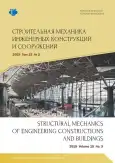Method of full discretization in joint calculation in time of the system “construction - foundation - soil”
- Авторлар: Ter-Emmanuilyan T.N.1, Polumordvinov I.O.2
-
Мекемелер:
- Russian University of Transport
- Kazakh-British Technical University
- Шығарылым: Том 15, № 3 (2019)
- Беттер: 171-181
- Бөлім: Analysis and design of building structures
- URL: https://journal-vniispk.ru/1815-5235/article/view/346268
- DOI: https://doi.org/10.22363/1815-5235-2019-15-3-171-181
- ID: 346268
Дәйексөз келтіру
Толық мәтін
Аннотация
Introduction. Prospective transition of CIS to the European design standards in the construction industry requires development of new and modification of known engineering methods for calculation and design of construction. Creation and development of such methods should be based on fundamental research that can become the basis for the development of principally new, innovative technologies. Methods. The paper consists of basis and practical application of the method of full discretization. This method is a special modification of finite element method for the solving of problems of the creep. Practical application of the method is illustrated with modeling and applied tasks. Results. The paper presents a joint calculation of the “structure - foundation - soil” system using the example of a reservoir of a modular biological wastewater treatment plant designed for filtration fields in the village of Tasboget, Akmola region, the Republic of Kazakhstan. The full picture of the evolution of the stress-strain state of structures is gained, taking into account the material creep and the history of construction. There is a comparison of result calculations with and without technology of erection of structures.
Авторлар туралы
Tatyana Ter-Emmanuilyan
Russian University of Transport
Хат алмасуға жауапты Автор.
Email: tanya_ter@mail.ru
Grand Ph.D., Professor, Department of Theoretical Mechanics
9 Obraztsova St., bldg. 9, Moscow, 127994, Russian FederationIgor Polumordvinov
Kazakh-British Technical University
Email: tanya_ter@mail.ru
Assistant Professor, Faculty of Oil and Gas Industry
59 Tole bi St., Almaty, A05H1T2, Republic of KazakhstanӘдебиет тізімі
- Chiorino M.A. (2014). Analysis of structural effects of time-dependent behavior of concrete: an internationally harmonized format. Concrete and Reinforced concrete - Glance at Future. III All Russian (International) Conference on Concrete and Reinforced Concrete, Moscow, 2014. Plenary papers (vol. 7, pp. 338-350).
- Fib Model Code for Concrete Structures 2010. (2013). Ernst & Sohn, 402.
- GOSSTROJ USSR; NIIZB. (1976). Polzuchest' i usadka betona i zhelezobetonnyh konstrukcij. Sostoyanie problemy i perspektivy razvitiya [Creep and shrinkage of concrete and reinforced concrete strictures. State of the problem and development prospects]. Moscow: Strojizdat Publ., 351. (In Russ.)
- Beglov A.D., Sanjarovsky R.S., Bondarenko V.M. (2005) Polzuchest' betona i modeli Evrostandartov [Creep of concrete and models of European standard]. Beton i zhelezobeton [Concrete and reinforced concrete], (2), 29-30.
- Bazant Z.P., Cedolin L. (2010). Stability of Structures: Elastic, Inelastic, Fracture and Damage Theories. World Scientific, 1009.
- Mahnken R.A. (1995). Newton-multigrid algorithm for elastoplastic-viscoplastic problems. Comput. Mech., 15, 408-425.
- McTavich D.J., Hughes P.C. (1992). Finite element modeling of linear visco-elastic structures; the GHM method. AHS Struct. Dyn. and Mater. Conf. Dallas, TX, 1753-1763.
- Mackerle J. (1998). Finite elements and boundary elements applied in plane change solidification and melting problems. A bibliography (1996-1998). Finite Elem. Anal. and Des., 32(3), 203-211.
- Zienkiewich O.C. (1975). Visco-Plasticity, Plasticity, Creep and Visco-Plastic Flow (Problems of Small, Large and Continuing Deformation). Lect. Notes Math., 461, 297-328.
- Ter-Emmanuilyan N.Ya. (1975). Metod prostranstvenno-vremennoi discretizazhii dlya resheniya linejnih zadach teorii polzuchesti: sbornik statei po voprosam matematiki i mekhaniki [Method of spatially time discretization for the decision of linear problems of the theory of creep: collected papers on questions of mathematics and the mechanics], 7, 16-22. (In Russ.)
- Ter-Emmanuilyan N.Ya., Ter-Emmanuilyan T.N. (2006). Metod polnoj discretizazhii dlya resheniya zadach uprugopolzuchesti [Method of full discretization for the decision problems of an elastic creep]. Almaty, 416 (In Russ.)
- Aitalyev Sh., Ter-Emmanuilyan N., Ter-Emmanuilyan T., Shmanov T. (2007). Joint calculation of a foundation and soil of the largescale structure in view of creep (pp. 159-168). Taylor & Francis Group, London.
- Aitalyev Sh., Ter-Emmanuilyan T. (2003). Method of full discretization in joint calculations of buildings and the bases in view of creep, spatial and time heterogeneity. Questions of applied physics and mathematics, 241-246.
- Arutyunyan N.H. (1952). Necotorye voprosy teorii polzuchesti. Moscow, Leningrad: Gostehteorizdat Publ., 323. (In Russ.)
- Ilyichev V. (2004). Experience of underground construction in Moscow. Works of the international geotechnical conference, Almaty, 41-42.
- Alexandrovskiy S.V. (1973). Raschet betonnyh i zhelezobetonnyh konstrukcij na izmenenie temperatury i vlazhnosti s uchetom polzuchesti [Calculation of concrete and reinforced concrete structures for changes in temperature and humidity, taking into account the creep]. Moscow: Strojizdat Publ., 432. (In Russ.)
- Erzhanov Zh.S., Karimbayev T.D. (1975). Metod konechnyh elementiv v zadachah mehaniki gornyh porod [The finite element method in the problems of rock mechanics]. Almaty: Nauka Publ., 238. (In Russ.)
- Ulitsky V.M., Shashkin A.G., Shashkin K.G., Lisyuk M. B. (2003). Soil-structure interaction: methodology of analysis and application in design. Saint Petersburg, Moscow, 40.
- Sanjarovsky R., Manchenko M. (2016). Errors in the theory of creep of reinforced concrete and modern norms. Structural Mechanics of Engineering Constructions and Buildings, (3), 25-32.
- Sanjarovskiy R., Ter-Emmanuilyan T., Manchenko M. (2015). Creep of Concrete and Its Instant Nonlinear Deformation in the Calculation of Structures. CONCREEP 10, 238-247.
- Sanzharovskij R.S., Manchenko M.M. (2017). Errors of international standards on reinforced concrete and rules of the Eurocode. Structural Mechanics of Engineering Constructions and Buildings, (6), 25-36.
- Sanzharovsky R.S., Ter-Emmanuilyan T.N., Manchenko M.M. (2018). Superposition principle as the fundamental error of the creep theory and standards of the reinforced concrete. Structural Mechanics of Engineering Constructions and Buildings, 14(2), 92-104. http://dx.doi.org/ 10.22363/1815-5235-2018-14-2-92-104
- Sanzharovsky R.S., Ter-Emmanuilyan T.N., Manchenko M.M. (2019). Three types of errors in the international norms for the design of concrete and reinforced concrete. Taylor & Francis Group, London.
- Ovchinnikov I.G., Pshenichnikov M.S. (1999). Polzuchesty betona i zhelezobetona: eksperimentalynye dannye, vliyanie ekspluatazionnyh phaktorov [Creep of concrete and reinforced concrete: experimental data, the influence of operational factors]. Saratov, 40. (In Russ.)
Қосымша файлдар









